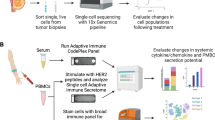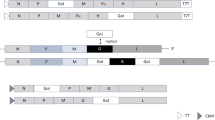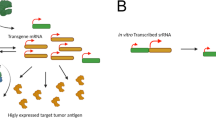Abstract
Cellular immunity against cancer can be achieved with viral vector- and DNA-based immunizations. In preclinical studies, cancer vaccines are very potent, but in clinical trials these potencies are not achieved yet. Thus, a rational approach to improve cancer vaccines is warranted. We previously demonstrated that the relatively low intrinsic immunogenicity of DNA vaccines could be enhanced by inclusion of endoplasmic reticulum (ER) targeting and universal helper epitopes within the vaccine. We now evaluated whether an optimal antigen format, as defined in DNA vaccines, can further enhance the effectiveness of recombinant Semliki Forest virus (rSFV) vaccines. To this purpose, we generated, characterized and evaluated the efficacy of rSFV replicon particles expressing human papillomavirus E6 and/or E7 proteins fused to several helper T-cell epitopes and an ER targeting signal. Here, we show that inclusion of a helper cassette and an ER targeting signal enhanced protein stability and markedly augmented the frequencies of human papillomavirus-specific T cells. Even at an immunization dose of as low as 105 replicon particles, this novel vaccine achieved tumor regression and protection. Thus, even highly effective viral vector vaccines can benefit from an improved antigen format, based on the inclusion of defined helper epitopes and ER targeting.
This is a preview of subscription content, access via your institution
Access options
Subscribe to this journal
Receive 12 print issues and online access
$259.00 per year
only $21.58 per issue
Buy this article
- Purchase on Springer Link
- Instant access to full article PDF
Prices may be subject to local taxes which are calculated during checkout





Similar content being viewed by others
References
Parkin DM, Bray F . Chapter 2: the burden of HPV-related cancers. Vaccine 2006; 24 (Suppl 3): S3/11–25.
Kristiansen E, Jenkins A, Holm R . Coexistence of episomal and integrated HPV16 DNA in squamous cell carcinoma of the cervix. J Clin Pathol 1994; 47: 253–256.
Arias-Pulido H, Peyton CL, Joste NE, Vargas H, Wheeler CM . Human papillomavirus type 16 integration in cervical carcinoma in situ and in invasive cervical cancer. J Clin Microbiol 2006; 44: 1755–1762.
Smith PP, Friedman CL, Bryant EM, McDougall JK . Viral integration and fragile sites in human papillomavirus-immortalized human keratinocyte cell lines. Genes Chromosomes Cancer 1992; 5: 150–157.
Ziegert C, Wentzensen N, Vinokurova S, Kisseljov F, Einenkel J, Hoeckel M et al. A comprehensive analysis of HPV integration loci in anogenital lesions combining transcript and genome-based amplification techniques. Oncogene 2003; 22: 3977–3984.
Moody CA, Laimins LA . Human papillomavirus oncoproteins: pathways to transformation. Nat Rev Cancer 2010; 10: 550–560.
Harper DM, Franco EL, Wheeler CM, Moscicki AB, Romanowski B, Roteli-Martins CM et al. Sustained efficacy up to 4.5 years of a bivalent L1 virus-like particle vaccine against human papillomavirus types 16 and 18: follow-up from a randomised control trial. Lancet 2006; 367: 1247–1255.
Garland SM, Hernandez-Avila M, Wheeler CM, Perez G, Harper DM, Leodolter S et al. Quadrivalent vaccine against human papillomavirus to prevent anogenital diseases. N Engl J Med 2007; 356: 1928–1943.
Hildesheim A, Herrero R, Wacholder S, Rodriguez AC, Solomon D, Bratti MC et al. Effect of human papillomavirus 16/18 L1 viruslike particle vaccine among young women with preexisting infection: a randomized trial. JAMA 2007; 298: 743–753.
Nakagawa M, Stites DP, Farhat S, Sisler JR, Moss B, Kong F et al. Cytotoxic T lymphocyte responses to E6 and E7 proteins of human papillomavirus type 16: relationship to cervical intraepithelial neoplasia. J Infect Dis 1997; 175: 927–931.
de Jong A, van Poelgeest MI, van der Hulst JM, Drijfhout JW, Fleuren GJ, Melief CJ et al. Human papillomavirus type 16-positive cervical cancer is associated with impaired CD4+ T-cell immunity against early antigens E2 and E6. Cancer Res 2004; 64: 5449–5455.
Piersma SJ, Jordanova ES, van Poelgeest MI, Kwappenberg KM, van der Hulst JM, Drijfhout JW et al. High number of intraepithelial CD8+ tumor-infiltrating lymphocytes is associated with the absence of lymph node metastases in patients with large early-stage cervical cancer. Cancer Res 2007; 67: 354–361.
Daemen T, Regts J, Holtrop M, Wilschut J . Immunization strategy against cervical cancer involving an alphavirus vector expressing high levels of a stable fusion protein of human papillomavirus 16 E6 and E7. Gene Therapy 2002; 9: 85–94.
Daemen T, Riezebos-Brilman A, Regts J, Dontje B, van der Zee A, Wilschut J . Superior therapeutic efficacy of alphavirus-mediated immunization against human papilloma virus type 16 antigens in a murine tumour model: effects of the route of immunization. Antivir Ther 2004; 9: 733–742.
Riezebos-Brilman A, Walczak M, Regts J, Rots MG, Kamps G, Dontje B et al. A comparative study on the immunotherapeutic efficacy of recombinant Semliki Forest virus and adenovirus vector systems in a murine model for cervical cancer. Gene Therapy 2007; 14: 1695–1704.
Riezebos-Brilman A, Regts J, Freyschmidt EJ, Dontje B, Wilschut J, Daemen T . Induction of human papilloma virus E6/E7-specific cytotoxic T-lymphocyte activity in immune-tolerant, E6/E7-transgenic mice. Gene Therary 2005; 12: 1410–1414.
Lin K, Roosinovich E, Ma B, Hung CF, Wu TC . Therapeutic HPV DNA vaccines. Immunol Res 2010; 47: 86–112.
Hung CF, Hsu KF, Cheng WF, Chai CY, He L, Ling M et al. Enhancement of DNA vaccine potency by linkage of antigen gene to a gene encoding the extracellular domain of Fms-like tyrosine kinase 3-ligand. Cancer Res 2001; 61: 1080–1088.
Chen CH, Wang TL, Hung CF, Yang Y, Young RA, Pardoll DM et al. Enhancement of DNA vaccine potency by linkage of antigen gene to an HSP70 gene. Cancer Res 2000; 60: 1035–1042.
Oosterhuis K, Ohlschlager P, van den Berg JH, Toebes M, Gomez R, Schumacher TN et al. Preclinical development of highly effective and safe DNA vaccines directed against HPV 16 E6 and E7. Int J Cancer 2011; 129: 397–406.
Michel N, Osen W, Gissmann L, Schumacher TN, Zentgraf H, Muller M . Enhanced immunogenicity of HPV 16 E7 fusion proteins in DNA vaccination. Virology 2002; 294: 47–59.
Rice J, Ottensmeier CH, Stevenson FK . DNA vaccines: precision tools for activating effective immunity against cancer. Nat Rev Cancer 2008; 8: 108–120.
Oosterhuis K, Aleyd E, Vrijland K, Schumacher TN, Haanen JB . Rational design of DNA vaccines for the induction of human papillomavirus type 16 E6- and E7-specific cytotoxic T-cell responses. Hum Gene Ther 2012; 23: 1301–1312.
Martial JA, Hallewell RA, Baxter JD, Goodman HM . Human growth hormone: complementary DNA cloning and expression in bacteria. Science 1979; 205: 602–607.
Munro S, Pelham HR . A C-terminal signal prevents secretion of luminal ER proteins. Cell 1987; 48: 899–907.
Rivera VM, Wang X, Wardwell S, Courage NL, Volchuk A, Keenan T et al. Regulation of protein secretion through controlled aggregation in the endoplasmic reticulum. Science 2000; 287: 826–830.
Walczak M, de Mare A, Riezebos-Brilman A, Regts J, Hoogeboom BN, Visser JT et al. Heterologous prime-boost immunizations with a virosomal and an alphavirus replicon vaccine. Mol Pharm 2011; 8: 65–77.
Ohlschlager P, Pes M, Osen W, Durst M, Schneider A, Gissmann L et al. An improved rearranged human papillomavirus type 16 E7 DNA vaccine candidate (HPV-16 E7SH) induces an E7 wildtype-specific T cell response. Vaccine 2006; 24: 2880–2893.
Peng S, Trimble C, Wu L, Pardoll D, Roden R, Hung CF et al. HLA-DQB1*02-restricted HPV-16 E7 peptide-specific CD4+ T-cell immune responses correlate with regression of HPV-16-associated high-grade squamous intraepithelial lesions. Clin Cancer Res 2007; 13: 2479–2487.
Kennedy R, Celis E . Multiple roles for CD4+ T cells in anti-tumor immune responses. Immunol Rev 2008; 222: 129–144.
van Poelgeest MI, van Seters M, van Beurden M, Kwappenberg KM, Heijmans-Antonissen C, Drijfhout JW et al. Detection of human papillomavirus (HPV) 16-specific CD4+ T-cell immunity in patients with persistent HPV16-induced vulvar intraepithelial neoplasia in relation to clinical impact of imiquimod treatment. Clin Cancer Res 2005; 11: 5273–5280.
Swain SL, McKinstry KK, Strutt TM . Expanding roles for CD4(+) T cells in immunity to viruses. Nat Rev Immunol 2012; 12: 136–148.
Bevan MJ . Helping the CD8(+) T-cell response. Nat Rev Immunol 2004; 4: 595–602.
Janssen EM, Lemmens EE, Wolfe T, Christen U, von Herrath MG, Schoenberger SP . CD4+ T cells are required for secondary expansion and memory in CD8+ T lymphocytes. Nature 2003; 421: 852–856.
Bins AD, Wolkers MC, van den Boom MD, Haanen JB, Schumacher TN . In vivo antigen stability affects DNA vaccine immunogenicity. J Immunol 2007; 179: 2126–2133.
Freigang S, Eschli B, Harris N, Geuking M, Quirin K, Schrempf S et al. A lymphocytic choriomeningitis virus glycoprotein variant that is retained in the endoplasmic reticulum efficiently cross-primes CD8(+) T cell responses. Proc Natl Acad Sci USA 2007; 104: 13426–13431.
Martins I, Kepp O, Schlemmer F, Adjemian S, Tailler M, Shen S et al. Restoration of the immunogenicity of cisplatin-induced cancer cell death by endoplasmic reticulum stress. Oncogene 2011; 30: 1147–1158.
Smahel M, Polakova I, Duskova M, Ludvikova V, Kastankova I . The effect of helper epitopes and cellular localization of an antigen on the outcome of gene gun DNA immunization. Gene Therary 2014; 21: 225–232.
Acknowledgements
We thank Oana Draghiciu and Tjarko Meijerhof for animal technical support and Stephanie van de Wall for carefully reading the manuscript. This study is funded by an Ubbo Emmius grant.
Author information
Authors and Affiliations
Corresponding author
Ethics declarations
Competing interests
T Daemen and HW Nijman are co-founders of ViciniVax, a spin-off company from the University Medical Center Groningen developing therapeutic cancer vaccines. TN Schumacher, JB Haanen and K Oosterhuis are inventors on a patent application covering vaccine formats and are as such entitled to a fraction of possible future royalty income, as per NKI-AVL regulations.
Additional information
Supplementary Information accompanies this paper on Gene Therapy website
Supplementary information
Rights and permissions
About this article
Cite this article
Ip, P., Boerma, A., Walczak, M. et al. Antigen design enhances the immunogenicity of Semliki Forest virus-based therapeutic human papillomavirus vaccines. Gene Ther 22, 560–567 (2015). https://doi.org/10.1038/gt.2015.24
Received:
Revised:
Accepted:
Published:
Issue Date:
DOI: https://doi.org/10.1038/gt.2015.24
This article is cited by
-
An alphavirus-based therapeutic cancer vaccine: from design to clinical trial
Cancer Immunology, Immunotherapy (2019)
-
Perspectives for therapeutic HPV vaccine development
Journal of Biomedical Science (2016)



